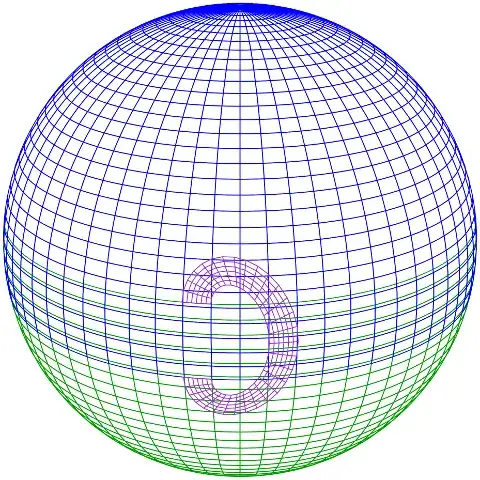Suppose there is an immersion $f$ from the closed disc $D^n$ to the sphere $\mathbb S^n$ (with the standard differential structures), where $n\ge 2$. Then can this map be surjective? I kind of hope it can't be, but have no idea....
-
Do you mean $D^n$ to $S^{n-1}$, i.e. $D^n$ to $\partial D^n$? Or actually $D^n$ to $S^n$? – Pete Caradonna Aug 31 '16 at 12:55
-
@PeteCaradonna It has to be $D^n \to S^n$, otherwise the dimensions don't match. – Najib Idrissi Aug 31 '16 at 12:56
-
@changer What do you mean by a "local diffeomorphism" when one of the manifolds has a boundary? – Najib Idrissi Aug 31 '16 at 12:56
-
Yeah, it's $D^n$ to $S^n$. – tomography Aug 31 '16 at 12:56
-
@NajibIdrissi Oh that's true, good shout. – Pete Caradonna Aug 31 '16 at 12:57
-
For the boundary point, the Jacobian has full rank. Or should I use submersion or immersion? – tomography Aug 31 '16 at 12:59
-
Is $D$ the closed disc or open disc? – Aug 31 '16 at 19:23
-
@ArcticChar The closed one. – tomography Aug 31 '16 at 23:31
-
Does 'painting a sphere by a correction tape ($D^2$ elongated in one direction)' work? – Sangchul Lee Sep 01 '16 at 01:57
-
@SangchulLee Um... what exactly is that? – Sep 01 '16 at 01:58
-
3Imagine you stretch $D^2$ so that it looks like a long tape. It seems to me that finding a surjective immersion would be roughly equivalent to covering $S^2$ with this tape without 'wiggle', like you are painting the sphere with a correction tape. Although hard to describe mathematically, I guess this is possible. – Sangchul Lee Sep 01 '16 at 02:03
-
@Hwang the picture (if I understand correctly) is to cover $\mathbb S^2$ with a long tape ${(x, y) : 0\le x\le 1}$ and then later find a diffeomorphism from $D^2$ to a big part of this long tape. – Sep 01 '16 at 02:11
-
@Arctic Char, thanks. I was wrong. – Hwang Sep 01 '16 at 02:17
-
1@SangchulLee As, for example, thickening the coiled spring pattern of the shaker? https://images-na.ssl-images-amazon.com/images/I/41rCk16f%2BEL.jpg – Neal Sep 01 '16 at 02:20
-
2@Neal, Yes! Or similarly, 'ball of yarn' with thin and wide string would also work. – Sangchul Lee Sep 01 '16 at 02:23
1 Answers
$\newcommand{\Reals}{\mathbf{R}}\newcommand{\Vec}[1]{\mathbf{#1}}\newcommand{\Basis}{\mathbf{e}}\newcommand{\eps}{\varepsilon}$For every $n \geq 2$, there exists a surjective immersion from a "barbell" comprising two $n$-balls joined by a solid cylinder to the $n$-sphere:
Here's a sketch of a construction.
Denote polar coordinates on the $n$-ball by $(r, \Vec{x})$, with $0 \leq r$, $\Vec{x}$ in $S^{n-1}$, and define $P:\Reals^{n} \to S^{n}$ by $$ P(r, \Vec{x}) = (\sin r)\Vec{x} + (\cos r)\Basis_{n+1}. $$ The map $P$ is an immersion in the open ball of radius $\pi$ centered at the origin.
Fix $0 < \eps < \frac{\pi}{2}$, and let $B_{1}$ and $B_{2}$ be the (disjoint) balls of radius $\frac{\pi}{2} + \eps$, with respective centers $\Vec{p}_{1} = \Vec{0}$ and $\Vec{p}_{2} = (2\pi, 0, \dots, 0)$. Map their union to the $n$-sphere by \begin{align*} \Vec{p}_{1} + (r, \Vec{x}) &\mapsto P(r, \Vec{x}), \\ \Vec{p}_{2} + (r, \Vec{x}) &\mapsto -P(-r, \Vec{x}) = (\sin r)\Vec{x} - (\cos r)\Basis_{n+1}. \end{align*} In words, map $B_{1}$ (blue) to cover a neighborhood of the northern hemisphere, and $B_{2}$ (green) to cover a neighborhood of the southern hemisphere.
Now take a smooth curve that starts at the boundary of the image of $B_{2}$ traveling "north", and ends at the boundary of the image of $B_{1}$ coming from the "south". Thicken this (in $S^{n}$) into a tube (purple). Modulo details of patching, this constructs a surjective immersion from the union of two balls and a cylinder to the $n$-sphere.
- 78,195
